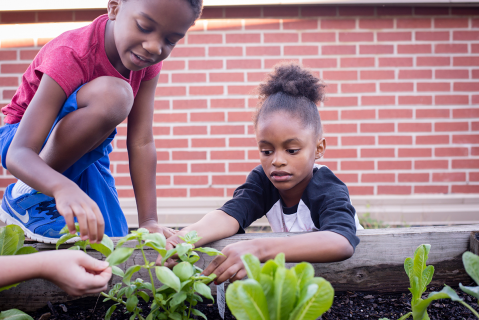
While advocates may readily self-identify as interested in either food access or in active transportation, local communities don’t always see the distinction between these issues. Communities rightly see the issues as interconnected, suggesting that our approach to solving it should be as well.
At the Safe Routes Partnership, we strive to help communities become places where it is easy for people to walk and bike safely to school and other places of interest in communities. Research shows that when conditions are safe, when transportation is accessible and affordable, and when infrastructure is connected to local destinations, people are more likely to choose to walk, bike, or use public transit.1 Beyond schools, we’re working to support connecting people to places they want to go, such as parks, health centers, and places to buy and obtain food.
In low-income communities, rural communities, and communities of color, which are less likely to have a grocery store close to home and where people are less likely to own a vehicle, it is of particular importance to ensure that it is safe, convenient, and affordable to walk, bicycle, or take public transit to access food. Low-income people and people of color in urban areas face the most dangerous street conditions and often lack bicycle and pedestrian infrastructure, resulting in high rates of injury and fatality.2 In rural places, 1.6 million people do not have cars, and so multimodal transportation options are sorely needed to reach healthy food store.3
At the Safe Routes Partnership, we see an opportunity to work together with our partners focused on food access to identify strategies that make it convenient and affordable for people to walk, bicycle, or take public transit to access nutritious foods at prices they can afford. We’re calling the work of overcoming the transportation challenges to healthy food access Safe Routes to Healthy Food.
We’ve begun this work by conducting research on the state of the field, developing an understanding of where communities are working on active transportation and food access together, how people are talking about the issue and seeing the connections, and where opportunities are. We’ve conducted dozens of key informant interviews and partnered with ChangeLab Solutions to conduct an environmental scan of where this work is happening across the country.
Through our role as the Voices for Healthy Kids Community Consortium lead, we are facilitating the Safe Routes to Healthy Food Task Force in partnership with The Food Trust, a nationally recognized non-profit working on food access. The role of the task force is to co-develop the field of practice and recommend strategies for stakeholders makes it easier, safer, and more convenient for people to walk, bike, and take transit to where they access food.
Task Force Members
Active Living By Design, Danielle Sherman
Bicycle Coalition of Greater Philadelphia, Waffiyyah Murray
ChangeLab Solutions, Juell Stewart
Cultiva La Salud, Genoveva Islas
Johns Hopkins Center for a Livable Future, Karen Banks
Living Streets Alliance, Vanessa Cascio
Mobility Lab, Paul Mackie
ModeShift Omaha, Madison Haugland
NAACP, Bernadette Onyenaka
Prevention Institute, Julie Leung
Public Health Law Center, Julie Ralston-Aoki
Safe Routes Partnership, Marisa Jones
Safe Routes Partnership, Sara Zimmerman
The Food Trust, Caroline Harries
The Food Trust, Kamaryn Norris
Voices for Healthy Kids, Tim Vaske
Voices for Healthy Kids, Kim Millbrath
Voices for Healthy Kids, Aaron Doeppers
1 Zimmerman S, et al. 2015; See also: National Association of Realtors and Portland State University. “Community and Transportation Preferences Survey: US Metro Areas, 2015.” Available at: http://ppms.otrec.us/media/project_files/NAR-PSU_2015_CT_Preferences_Survey_Report-1.pdf.
2 The New Majority: Pedaling Towards Equity. 2013. The League of American Bicyclists and The Sierra Club. Available at: www.bikeleague.org/sites/default/files/equity_report.pdf.
3 Forbes GS. 2012. “Putting Transit to Work in Small Towns and Rural Places.” Reconnecting America. Available at: www.reconnectingamerica.org/assets/Uploads/ruralplatformmarch2012.pdf.

